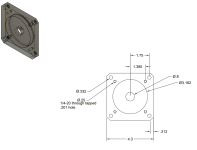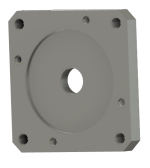madmachinst
Stainless
- Joined
- Jan 15, 2007
- Location
- Central FL
OK here is the video of my worth a try hairbrained scheme If it don't work no time wasted.
Any suggestions?
Any suggestions?
Last edited:
Its a retrofit. 1991 BP V2XT. I retrofitted with closed loop mach motion system. Never replaced the belt but did replace the servo. This meant adapter plate for servo and everything shifted a little to the tight end, IE away from the ball screw say .04-.07" . Originally thought cause belt was off those two pulleys for a long time. I guess not.Did the accuracy issue start when you replaced the belt? Or have you just fired up the machine and trouble shooting accuracy.
Mach 4. Step count can be adjusted, but throughout the travel of the screw, step count can be as different as 30 steps per inch. On 25000 steps per inch that comes out to like .0012The step count can be adjusted in the control. Are you running Mach or another control? I didn't recognize the screen as it passed by in the video.
I notice that with the belt stretched too tightly, beyond spec as I explained in the video, sometimes the encoder is fighting itself so to speak, and all kinds of other weird things happening. I don't expect stretching the belt to change pulley ratio, but would like to get one consistent steps per inch throughout the travel of the screw.Stretching the belt won't change the pulley ratio.
Give it a break, that machine is from 1991. Saw pictures of a German servo from a V2, saw a similar looking beast with tachometer on it just like the old SEM servo this thing had.Sorry, I can't answer your question directly but can advise the belt will not stretch. It might wear but won't stretch. Probably not even a cheap chinese knock off with a polyester carcass. Now my rant, why do cnc machine manufacturers insist on using motor mounted encoders instead of dro like scales directly mounted on the machine axis. Get rid of the fancy drive and belt problems. Use the traditional power feed systems. It would make converting manual machines much more straight forward too.
Spec says that this belt should deflect 1/4" with 17 lbs of force applied. This thing is guitar string tight and I suspect why I am getting inaccuracy through the travel of the table. When I get it within .00075" error throughout its travel, will be happy to rely on the screw mapping feature in the controller. Belts and pulley are original to machine.What is the problem???
I can not see what kind of belt/pulleys you are using. The sort of square teeth or the round teeth?
Trapezoidal or square looking is not so great at positioning and more for just drive apps.
Ratio and spacing distance looks good to me.
I am not understanding the question. We need more info.
The thing with this reduction is belts are not perfect tooth to tooth and the contact runout on a pulley is not the OD runout.
Bob
(Please take no offense from this post, so many questions and me still learning )
Yes, it worked before changing servos. Old servo mounting plates had slots not holes for the mounting screws. I don't have them or any way to drive them anymore. I need to go with what I have. .01 is 1/20 of a leadscrew turn. I have a pulley from the servo driving a 2X bigger pulley on the leadscrew. Wish I could apply heat with heat gun on belt and that will loosen tension. If only life was that simple. I really hate to think might have to trim metal off the mounting flange on the TECO servos. I hate modifying expensive parts.Tooth belts do not slip. I think you are looking for hardware or servo tuning issue.
How much turn on lead screw is .01”? Mapping is for chasing tenths or really Really bad screws.
Did it work before you started changing parts?


3 number code for what? explain elaborate a lot. These are auto tuning.Servos needs tuned. Each just needs a simple* 3 number code entered, nothing hard like 4 holes.
*simple is relative, ie simple relativity.
This gets complicated fast and there are torque, velocity and positioning amp systems.mr Carbide, how to you get I value over p value to start the tuning voodoo ratio? Honestly interested because you know more about this than most.

Yes it is a step and direction type system. The step pulse generator/ BOB gets feedback back from encoder to see if any corrections need to be made or if error too great and then servo gets disabled. Happened to me once before belt got loosened. When I have next session with tech support and machine hooked to network will ask him about query and see if too much error.What? Steps per inch or degree do not change. This is pure math. Do not try to calibrate it. If it disagrees with the math look deeper.
Guessing what we have here is a step/direction into a servo drive. I do not like this for many reasons but it is very common and used by many.
This puts a loop into this drive. Different approach speeds give different check results although not sure how these checks are being done.
"I" term in the drive is bad or some others like a bad screw but that rare indeed.
Self tuning gets you in the ballpark but is not so great. More like a starting point for the settings.
Can you query the drive as to where it is sitting and error?
Error is less on one end? Way alignment and torque needed different? Backlash and acc/dec curve vs mass?
A confusing and interesting problem.
Bob
Notice
This website or its third-party tools process personal data (e.g. browsing data or IP addresses) and use cookies or other identifiers, which are necessary for its functioning and required to achieve the purposes illustrated in the cookie policy. To learn more, please refer to the cookie policy. In case of sale of your personal information, you may opt out by sending us an email via our Contact Us page. To find out more about the categories of personal information collected and the purposes for which such information will be used, please refer to our privacy policy. You accept the use of cookies or other identifiers by closing or dismissing this notice, by scrolling this page, by clicking a link or button or by continuing to browse otherwise.
